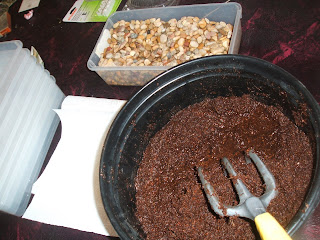I have a little free time (2 days off work), a lotta help (my husband) and an 8x4 foot garden bed that's been cleared of last seasons crops. My project is to amend, fill with soil and plant the bed for as little cost as possible, and I will be throwing in a few of the frugal garden tips I've been waiting to pass along. I'm almost out of compost, and the little bit I have isn't ready yet so I have to supplement by buying bags of potting soil. The best price I could find is $6.99 for 2 cubic feet. I figure it will take me about 5 bags when all is said and done, so the cost will be about $35.00 plus tax. I also picked up fresh seeds, 2 types of carrots (French Bolero and King Midas), Beets (Jewel mix) and Corn (Bon Jour). This added another $8.00 plus tax to the total. I will be adding Spaghetti squash and black beans to the mix, but those seeds were harvested from my yard last year so I get a few freebies. While I realize $43.00 plus tax isn't cheap, it's a small price to pay for local, organic produce.
The bed was filled with roots from some of the prior crops, and we worked through it to pull out as much of it as possible. This is hard work, but when shared with a partner, it's not half as bad.
When most of the roots were cleared away we made trenches in the soil and buried the partially composted materials that I had on hand.
We topped everything off with the 5 bags of potting soil. A sixth bag would have been better, but erring on the side of frugal, I only bought 5 so we had no choice but to stop there.
I carefully "planted" 2 empty 1 gallon pots and 4-4" pots into the raised bed. Why would someone do that you might ask? Let me tell you why. When I water I'm able to get a little extra moisture to the roots of the plants, and when I add fertilizer, compost or worm castings to the pots the nutrients slowly leech into the soil, feeding and watering the roots of my plants at the same time.
I used an old broom stick and a tape measure to figure my layout, spacing plants far enough apart that they won't have to compete with their neighbor for food & water. I have to plan carefully If I want to get the most out of this tiny space.
I started by planting 2 rows of carrots and a row of beets. I finished with "The 3 Sisters", 2 rows of corn interplanted with beans (that climb up the corn) and 4 hills of squash (which crawl across the bed and shades the soil). The squash tends to sprawl quite a bit, and usually ends up on the lawn at some point.
A few pieces of chicken wire placed directly on the bed helps to keep out cats that might be looking for a littler box spot. Making sure the bed stays damp will also help to keep out the kitties, and the water works double duty since constant moisture is important to success with seed germination. Once the plants get bigger the cats won't bother them as much, so I'll can move the wire to another area.
I've planted a lot of produce in a small space. I can't wait to show it off and share the bounty.
Be well and happy gardening!
05/19/11
Follow up:
This garden looks amazing! Everything is growing better than expected. The front of the bed shows the carrots and beets. The back of the bed is my 3 sisters garden (corn, beans and squash) a combination that was started by native American gardeners. To keep out the wild life (cats, dogs and raccoons) and provide additional support to the plants, my husband used rebar and fishing line around the border and through the center of the bed.
Watch each week as I update the pics.
Follow up: 06/04/2011:
I've been gone a few days. It's always exciting to see how much things change in a short time. The corn is taller than the tops of the rebar.
The front of the bed looks great.
The squash plant has a few blossoms, but no fruit yet.
The beans have small purple flowers. None of the vines are winding around the corn, though.
I have beets that are ready to harvest, and I've already cooked up some of the beet greens. The carrots, while bushy and pretty aren't even close to being ready yet.
A few neighbor's have commented on how nice the garden looks and I have been able to share a few thoughts and tips about growing your own food.
Be Well and Happy Gardening!




















































